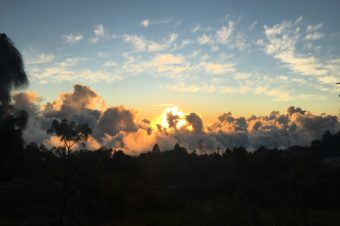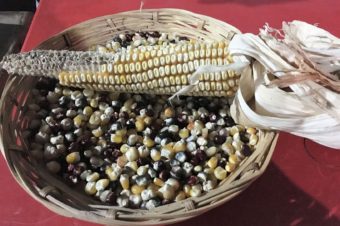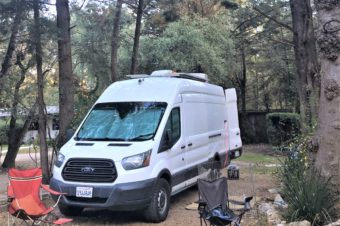San Juan Chamula is just a 20-minute drive from the tourist favorite, San Cristóbal de las Casas. So close and yet so different, a visit to the indigenous, insular community of Chamula is like stepping into another world. Chicken sacrifices, Coca-Cola in religious ceremonies, strict rules against photography – these are just some of what makes Chamula worth a visit.
A day trip to the indigenous Tzotzil community of San Juan Chamula is one of the best things to do when visiting San Cristóbal de las Casas in Chiapas, Mexico.
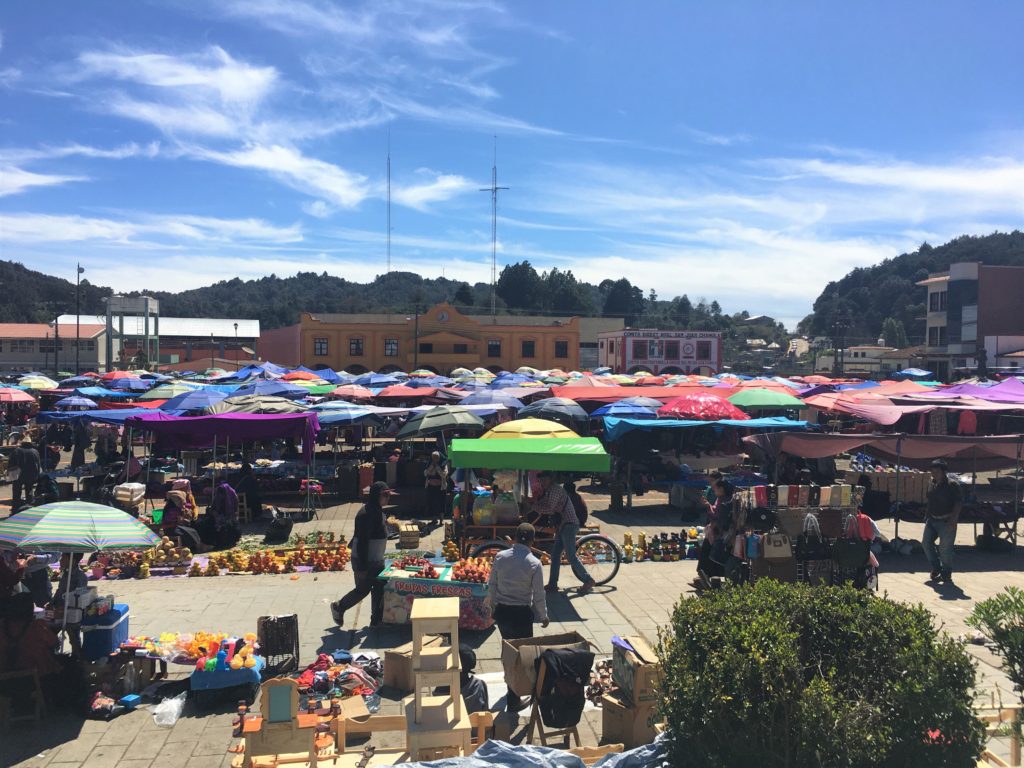
Table of Contents
Tours vs. Do-It-Yourself
I know, I know. If you’re even reading this, especially from a source like me, it probably means you want to DIY your trip. We’re usually inclined to explore on our own as well.
But in this case, in a town where outsiders can make any number of offensive and disruptive faux-pas, where nearly every facet of the community requires some explanation or narration, where the primary language is not Spanish, I recommend going with a tour.
The social, cultural, and religious practices of this town are so different and at times so hidden that you’ll want much more information and elucidation than any blog could tell you or show you. Save yourself the disappointment of wandering without the context; book a tour!
If a tour still doesn’t sound appealing to you, then at the very least you can hire a guide from the front of the church.
We Recommend: Alex Y Raul Tours
Alex Y Raul Tours leads culturally responsible tours to Chamula and Zinacantan. They’ve taken the care to develop relationships with the locals, speaking to them in their native Tzotzil. They have tours in (excellent) English and Spanish, departing daily at 9:30 am from the large cross in front of the cathedral in Plaza de la Paz. In January 2020, the cost was MXN 300 and includes transportation. You can send a Facebook message or an email to alexyraultours@yahoo.com.mx.
San Juan Chamula: Overview
What makes San Juan Chamula so special? Why am I going on and on about its uniqueness?
#1 An Independent Municipality
San Juan Chamula is an independent municipality. This means it is autonomous from federal and state governments. The only rules that exist are established by the local traditional, civic, and religious leaders of Chamula, including an elected mayor who serves for three years.
Not impressed? Well, what if I told you:
Legally: It means no traffic laws, no driver’s license, no age requirement (a.k.a. drive here at your own risk!). It means criminals are judged and punished here, as the leaders deem appropriate. It even means no taxes!
Culturally: It means Tzotzil is the primary language, not Spanish. It means polygamy is accepted here (always on the one-man-to-many-wives spectrum), and it means social services like schools and hospitals can follow their own systems, policies, and methods.
#2 A Strictly Indigenous Population
The “indigenous” in Mexico refers to those who can trace their roots back to the communities that existed in Mexico before the arrival of Europeans. Most commonly, you’ll hear about the Aztecs, Mayans, Zapotecs, and Mixtecs.
These indigenous cultures have always struggled to maintain the customs, beliefs, and languages that form their identities.
No community, it seems, has done this better than the Tzotzil peoples of San Juan Chamula.
For a man to live in Chamula, they must be an indigenous Tzotzil. Men of any other descent, including Mexican, are not permitted to live in Chamula.
For a woman to live in Chamula, they must be either be an indigenous Tzotzil or be married to an indigenous Tzotzil. Otherwise, they are not permitted to live in Chamula.
For anyone to live in Chamula, they must follow the local religious belief and practices. Those who change from these practices are disenfranchised and exiled; some may even be separated from their families. Most move to San Cristóbal to start over – financially and socially, without the nest of familiarity and social services they’d received all their lives.
Although quite controversial, strict rules such as these have certainly helped Chamula retain its unique religious and cultural purity against larger outside forces.
#3 A Unique Dress Code
One of the first things you’ll notice about Tzotzil people is their distinct clothing. (Remember: even though it is very tempting to take a picture, you must ask permission first!)
Traditional women in Chamula wear shaggy black wool skirts. These skirts are one-size-fits-all rectangles of wool with the sides sewn together into a large square tube – no tailored fit here! These skirts are worn with the waist bunched up, secured with a belt. As an outsider, it seems like an incredibly heavy, bulky, and cumbersome item to wear. But at least it is rain-proof!
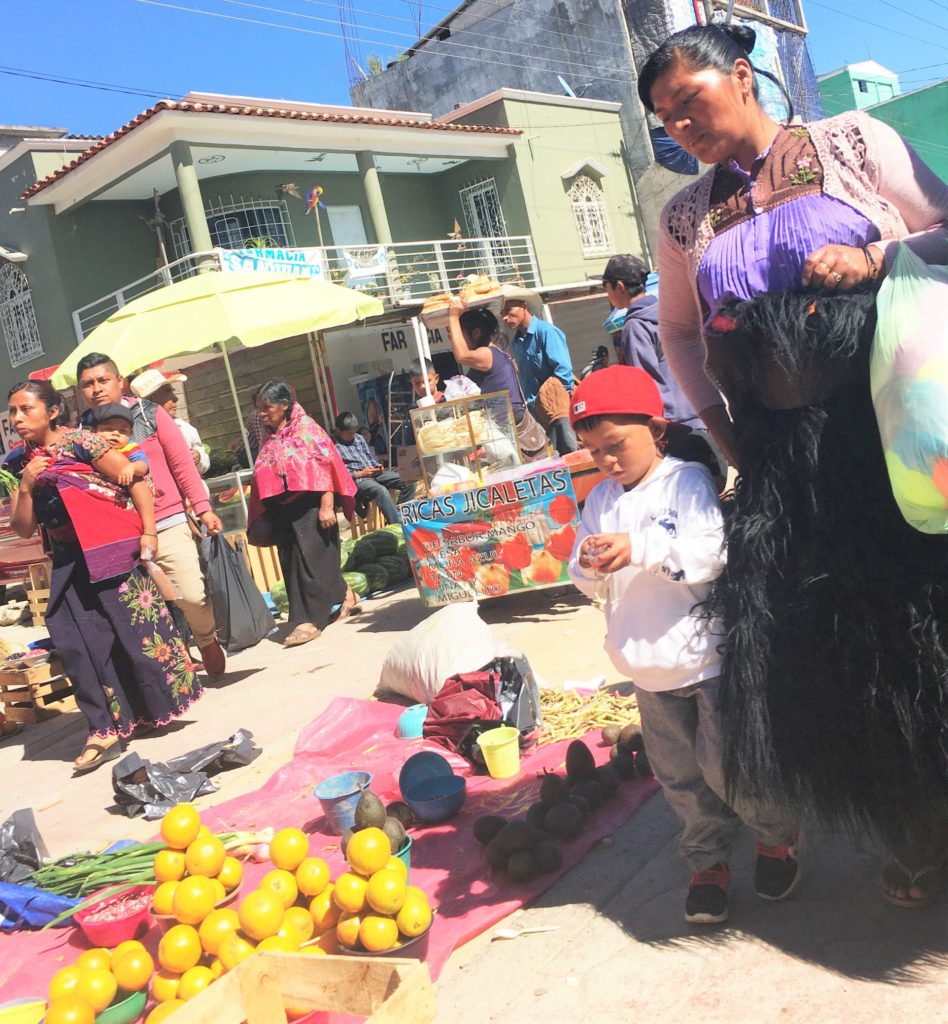
Traditional men in Chamula wear the same shaggy wool as a shirt, usually over button-down collared shirts. White shaggy wool is used for short-sleeve summer shirts. Black shaggy wool is used for long-sleeve winter shirts. While black wool can be dyed from any color fur, white wool can only be made from white sheep.
The length of the fur on a person’s clothing determines their class. The longer the fur, the higher the social standing. That’s because longer fur takes more sheep and more labor to produce, and thus is more expensive. You will also see women wearing black skirts with thin stripes – these are wool skirts with little to no fur – that signify they are of a lower class.
The religious, civic, and traditional leaders in Chamula also have their own special dress. Ribbons, tassels, hats, sticks, and instrumental rattles all play a part to distinguish leadership and importance in the community.
#4 The Houses of the Saints and its Religious Leaders
The Tzotzil are descendants of the ancient Mayans. Even after the Spanish forcibly converted the Tzotzil to Catholicism, these indigenous communities still maintained some of their traditional, Mayan beliefs.
This syncretism – the amalgamation of different cultures that together create a special blend – shows itself in the town’s wooden Mayan crosses with depictions of Jesus Christ in the center, a priest-less and pew-less “church” (I explain the quotation marks below), and prayers focused more on the Saints than on Jesus himself.
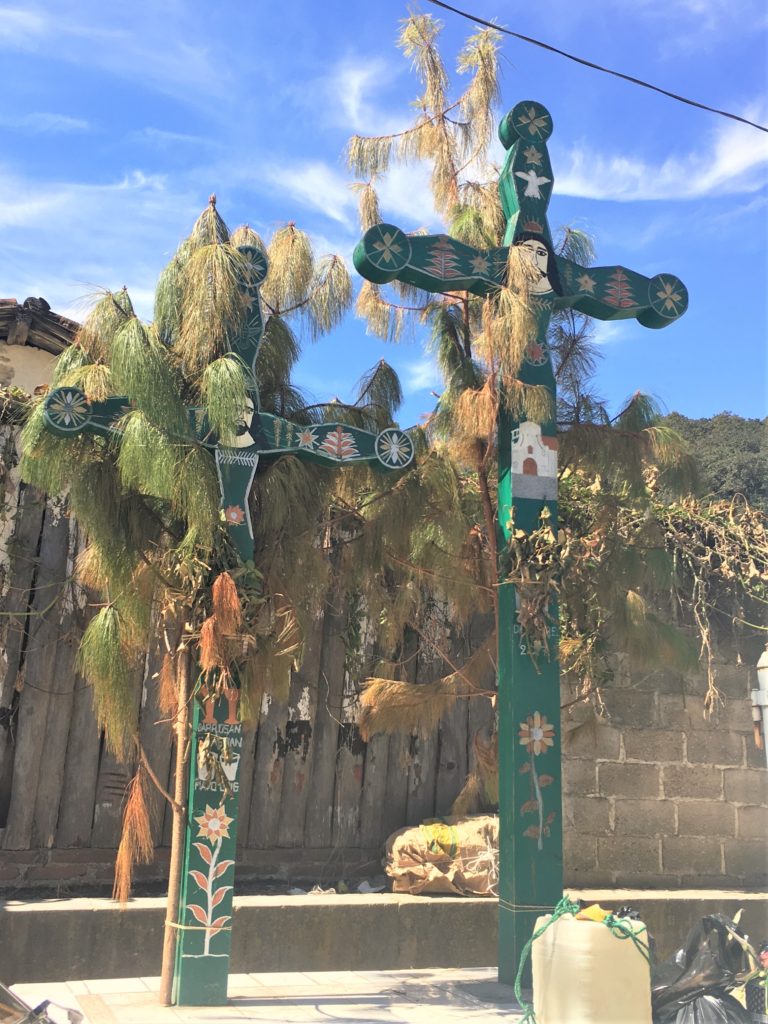
There are approximately 48 Saints honored in Chamula (if you want to know the exact number, you can count them in the church). For each Saint, there is a house of prayer. For each house of prayer, there are two religious leaders whose duty it is to care for the house and the Saint.
This means:
- Leading at least four prayers a day, throughout the day and night! Prayers usually involve lighting candles, chanting, burning copal resin (as spiritual cleansing), and drinking the ceremonial Mayan alcohol, pox (pronounced posh). Candles are believed to be the food of the Saints.
- Entertaining visitors who come to pray or socialize, which usually means inviting them to food and pox (see #6 below for more on pox). It may also mean fireworks, music, and parades.
- Maintaining a fresh carpet of aromatic, green pine needles on the floor. The pine is the tree of life in ancient Mayan belief, so you will find it everywhere in Chamula. It is believed that pine needles on the floor protect people from accidentally slipping into the underworld. These must be replaced weekly because candles and dried pine needles are not a good combination!
- Maintaining a dense wall of Tillandsia eizii bromeliads (orchids) around the Saint. These long, hanging plants serve as a barrier to protect the Saint from the sins of visitors and must be replaced every 4 months.
- Maintaining a thick layer of naranjillo branches on top of the altar, to freshen the air from the pervasive copal smoke. Naranjillo is often found draped around the town’s wooden crosses as well.
- And, last but certainly not least, paying for all of these costs – the pox, food, plants, décor, fireworks, music – out of their savings! Depending on the popularity of the Saint, a year of service can cost up to 1 million pesos! That is a lifetime of savings. So, not only do these religious leaders lose a year of income, but they pay for the honor of volunteering! Some end their service completely broke, selling their land to repay debts.
It sounds like a lot of work, right?! But the men who volunteer to be religious leaders earn tremendous honor and respect in the community. It is believed that a man is not complete until he serves, so you can imagine the peer pressure he must receive throughout his life from family and society to perform his duties as a Tzotzil man.
After volunteering to be a religious leader, a man can wait 10-15 years to be appointed. In the meantime, he works and he saves. He knows that when the time comes, he’s going to need a lot of money. Many will even leave their community to look for better earnings prospects, including seeking work in the United States.
The high cost is also the reason that women are never religious leaders. There is no rule that women cannot be religious leaders like there is with civic or traditional leadership, but women are not wage-earners in Chamula. It is their duty to care for the family and the home while the men work out in the fields. This is an uncompensated role, so it is nearly impossible for a woman to collect the resources required to serve as a religious leader.
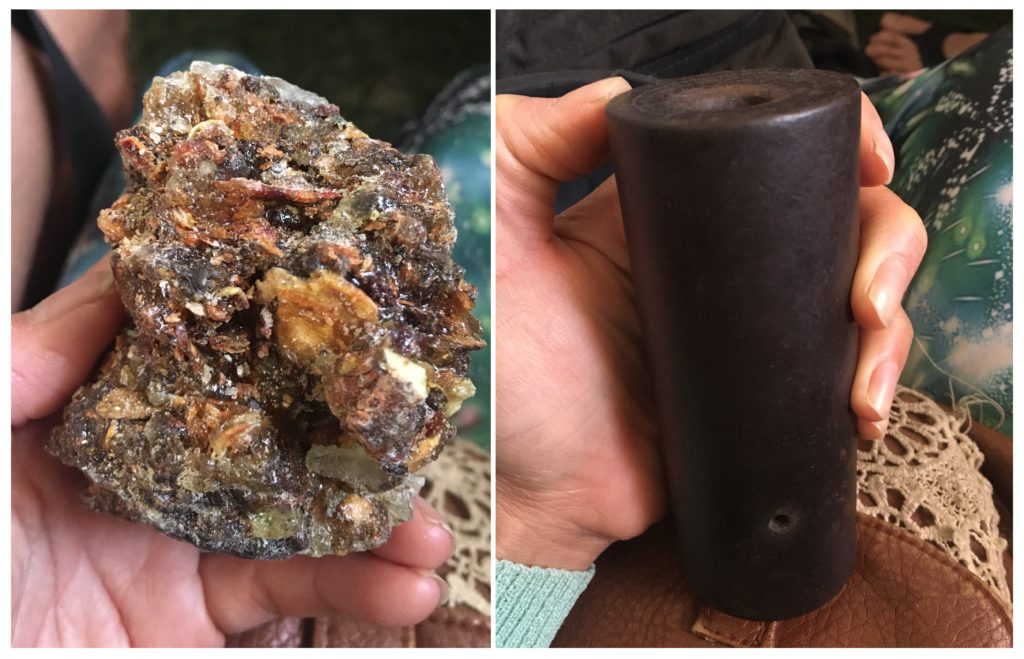
On the right: an iron cylinder used to light the camaro firework. Gunpowder is stuffed into both openings, lit, and held arms-length away for an explosive “crack”! Fireworks work like church bells, notifying everyone that a prayer or a procession is happening.
#5 The Church that is a Temple
The most remarkable sight in San Juan Chamula is the Iglesia de San Juan Chamula. It is open 24 hours a day, 7 days a week!
Though officially called an Iglesia (church), the locals usually refer to this house of prayer as a temple.
Why? Because the Catholic church does not recognize it as a church. There is no Catholic priest, there are no pews, and there are too many Mayan elements for what is quite a strict religion. Indeed, the Tzotzil are referred to as ‘traditionalist’ Catholics: Catholicism mixed with indigenous culture.
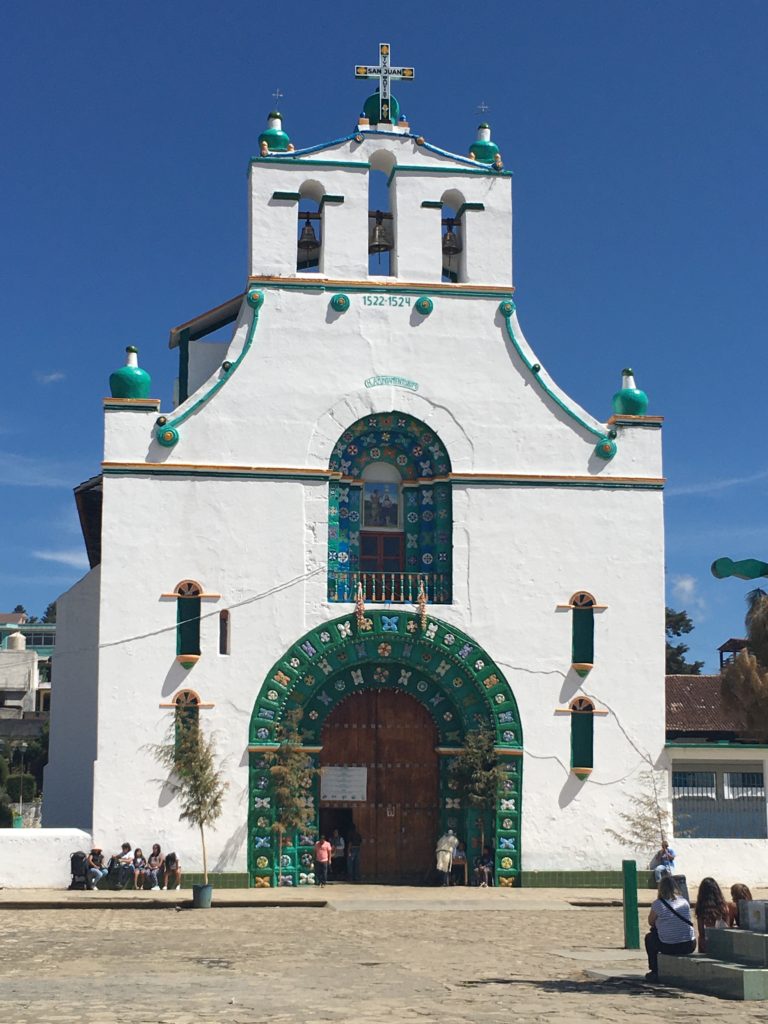
But whether you call it a church or a temple, this place is like nothing you’ve seen before.
I let out an audible gasp as I stepped through the doorway into the fairy-tale-like scene.
Inside, hundreds of candles form fiery seas of flickering light. The air is dense with fire, copal smoke, and respectful, hopeful whispers. Aromatic pine needles blanket the cool floor, refreshing the seemingly airless space. People pray, kneeling on the floor around multi-colored candles and bottles of clear pox and Coca Cola. Every so often, a chicken clucks from a cardboard box or bag. It is an eerie, somber, yet stunning environment.
This town is called San Juan Chamula after Saint John the Baptist. When the Chamulans pray, they pray mostly to Saint John, because it is generally believed that Christ himself is too busy to listen.
Saints have much more power in Latin American Catholicism. Statues of Saints line both sides of the church so that people can pray to specific Saints for specific issues. These Saints wear mirrors on their chests, to reflect the sins of visitors like you and me.
Pictures are especially not allowed within the church (trust me, eyes will be watching) but perhaps it is for the better: this is a sight to see for yourself.
There are always a few leaders available to monitor the activities: patrolling for prohibited phones and cameras, greeting and supporting constituents, cleaning candle wax from the floor, and keeping an eye out for potential fires. One of the leaders even chastised a couple from our tour who were hugging just a bit too closely.
#6 Healers in Chamula
In the Church of San Juan Chamula, healers (not priests) lead prayers.
The midwife identifies a healer at birth, usually based on a unique physical mark or deformity. These young healers are then trained in the ways of traditional Tzotzil healing methods – a combination of symbols, rituals, and chants for each affliction.
When a person hires a healer, they look to the healer to:
- Select the auspicious location on the temple floor for the prayer.
- Choose the color and arrangement of candles. For example, a white candle represents abundance and life, and black represents the expelling of evil. The candles can be arranged in a circle, a half-circle, a line, etc.
- Select the living elements of the prayer, such as eggs or a live chicken. The question of the chicken or the egg (no pun intended!) depends on the severity of the problem. The egg or the chicken is passed over the afflicted person’s body to absorb their unwanted negative energy. If a chicken must be sacrificed, the healer will quickly, gracefully snap its neck. (We were told they do not cut the neck because this would be black magic and pagan.)
- Choose the carbonated beverage. After the afflicted person has been cleansed by the chicken or the egg, they must expel their internal energies too. The best way to do this? By burping, of course! And, just like with candles, the color of the beverage also matters. Previously, they used chicha for this, a fermented beverage made of corn or other plants that happens to be black. Then came along Coca-Cola, a more appetizing black carbonated beverage. They may also use Fanta for orange, or Sprite for green.
- Instruct the family on what to do after the prayer. A chicken may be eaten or buried or a combination. Eggs are usually discarded. The healed person may be quarantined for a week or sent to pray further at the house of a saint. In many cases, the entire family is involved. For example, if the family shares in eating the chicken then they also share in carrying the affliction. It’s all quite beautiful and compassionate.

#7 Pox (Posh)
You will find pox everywhere in Chiapas, but in San Juan Chamula, it really is everywhere. We were told a single House (of a Saint) can go through 200 liters of pox every 20 days!
According to Wikipedia, the word “pox” in Tzotzil means “medicine, cane liquor, a cure.” Pox is an alcohol made of corn, sugar, and wheat. It is usually kept in recycled bottles and is so clear it looks like water – if water was 40% alcohol!
Our tour guide had quite an explanation to justify pox in religious ceremonies. Drinking pox is meant to open their hearts and minds, making it easier to express emotions and to reach an upper state of mind. Imagine a room filled with slightly inebriated, devoted believers, praying in unison to serve and honor their Saint.
Pox is all about perspective.
San Juan Chamula: Cemetery
Just outside of town is Chamula’s cemetery. It’s easy to spot: there are no walls and no roof, only long dirt mounds marked by large crosses and cascades of now brown pine needles.
There are a few headstones and ornamented tombs, but those are now forbidden. They are a reminder of the clash between Catholic religion and Mayan beliefs.
Today, graves are marked by simple crosses. Stone crosses are Christian. Wooden crosses are Mayan. Different colors characterize the deceased – white for babies, green for children, blue for young adults, and black for the older adults. The ever-present pine needles draped around the crosses represent the tree of life in Mayan tradition.
A visit to the cemetery is a frequent family affair. Many times a year, family and friends will gather for small fiestas at the cemetery. They clean and refresh the graves, play music, leave offerings, eat and drink (pox) together, and celebrate the person’s life. The men pray and the women laugh and cry.
In Mexico, when you’re dead you’re just in a different stage within the cycle of life. You are still a part of the family and the community.
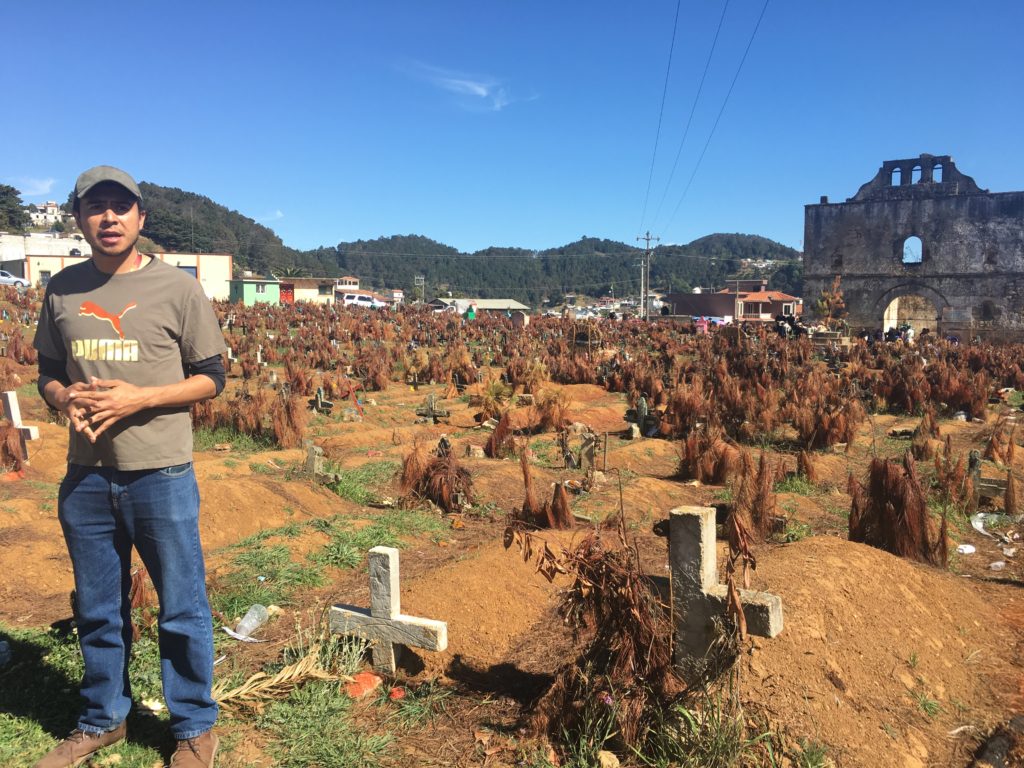
Tips for Visiting San Juan Chamula
Sunday Market
The best day to visit Chamula is on Sunday when the outdoor market is in full swing. Colorful umbrellas take over the plaza and locals set up their stalls of produce, meats, cheeses, and various goods. It’s nice to see in an otherwise empty plaza.
In Chiapas, vendors sell their goods in aesthetically pleasing, stacked measurements, called medidas. For example, you’ll see a stack of individual bananas, a pail of limes, a plate of peppers, a pyramid of oranges, etc. Instead of shopping by the kilo like elsewhere in Mexico, you’d ask, “Cuanto por la medida?” (How much for the measurement?).
We bought two bags worth of groceries and snacks but, I’m sorry to say, I was a little disappointed at the quality and prices at the Chamula market. It wasn’t awful; it just wasn’t great. I also highly recommend using a produce wash before consuming anything raw.
For fresher produce at a better price, I recommend the markets in San Cristobal.

Buying Wool
If you’re looking for an authentic souvenir from San Juan Chamula, look no further than wool. Handmade wool products are the thing to get here, whether it’s a jacket, scarf, hat, blanket, or purse.
There are other products of course, but they may or may not come specifically from Chamula. Vendors everywhere will sell what sells, whether or not it comes from Chamula, Chiapas, or even Mexico!
While you probably won’t be eager to rock an oversized, shaggy wool skirt (or maybe you are!) it is no question that wool products for sale in Chamula are indeed made in Chamula.
Understanding Chamula Further
While researching for this article, I came upon an amazing thesis paper produced by the Ciudad Universitaria Intercultural. Although it is in Spanish, it is an incredibly comprehensive study on the plants, rituals, society, economy, and tourism in Chamula.
If you want to learn more about this unique and intriguing community, this essay is worth your time. GoogleTranslate will be your best friend!
If you’re looking for an incredible experience, San Juan Chamula is the most culturally unique, indigenous town in all of Mexico. They display a commitment to their ancestral traditions that is truly impressive. It is a testament to the strength of their community despite centuries of colonization, evangelization, and modernization.
